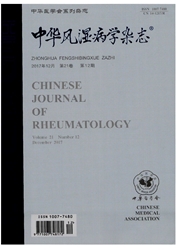

 中文摘要:
中文摘要:
系统性红斑狼疮(systemic lupus erythematosus,SLE)是一种多因素参与的自身免疫性疾病。研究证实,B淋巴细胞、T淋巴细胞、转录因子与细胞因子表达以及抗原呈递等异常或缺陷在SLE的发病中有重要作用,导致包括皮肤、肾、肺、中枢神经系统、消化系统及关节肌肉等多系统、多器官的损伤。
 英文摘要:
英文摘要:
Systemic lupus erythematosus( SLE) is a prototypic systemic autoimmune disease,which characterized by complex immunological abnormalities and multiple tissue and organ damages. The etiology and pathogenesis of SLE have not been entirely recognized. Genetic,environmental and viral infections and other factors might be related to the pathogenetic mechanisms of SLE. Interleukin-2( IL-2) is a critical cytokine produced by T cells upon activation and is important for the generation of T regulatory cells and activation-induced cell death. In SLE patients,T cells display decreased capacity to produce IL-2. Impaired IL-2 expression resulted in decreased generation of regulatory T lymphocytes,and defect of activation-induced cell death. Former researches indicated that IL-2 deficiency in SLE is important for the pathogenesis and treatment of SLE. Several regulating molecules can affect the transcription of IL-2gene and had an important role in the pathogenesis of SLE. These molecules include cyclic AMP-responsive element modulator( CREM),protein phosphatase 2A( PP2A),E-74 like factor 1( Elf-1),B lymphocyte induced maturation protein-1( Blimp-1) and interferon regulator factor 5( IRF-5). CREM is a transcriptional inhibitor that can repress the transcription of the IL-2 gene by binding to the promoter of the IL-2 gene. PP2 A is a Ser / Thr phosphatase that expressed in eukaryotic cells ubiquitously,it represents a negative regulator of the IL-2 gene promoter activity. Elf-1 belongs to the Ets family of transcription factors and can promote the expression of IL-2. Blimp-1 is a crucial transcription factors for regulating B lymphocyte terminal differentiation,an important function of Blimp-1 in T cells is to repress IL-2gene transcription directly. Interferon regulatory factors( IRFs) are distinctive transcriptional regulators of type Ⅰ interferons( IFNs) and IFN inducible genes,IRF-5 is a member of the IRFs family. IRF-5 is found to be increased in SLE and can regulate the production of
 同期刊论文项目
同期刊论文项目
 同项目期刊论文
同项目期刊论文
 The expression and clinical significance of different forms of Mer Receptor Tyrosine Kinase in Syste
The expression and clinical significance of different forms of Mer Receptor Tyrosine Kinase in Syste 期刊信息
期刊信息
